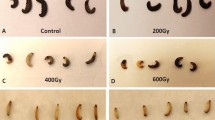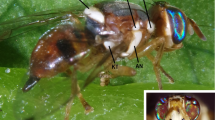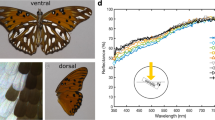Abstract
THE cuticle of the albino strain of Schistocerca gregaria is more or less colourless because of a complete absence of melanin and apparent utilization of a phenol substrate in the hardening process which does not give rise to a coloured scleroprotein.
This is a preview of subscription content, access via your institution
Access options
Subscribe to this journal
Receive 51 print issues and online access
$199.00 per year
only $3.90 per issue
Buy this article
- Purchase on Springer Link
- Instant access to full article PDF
Prices may be subject to local taxes which are calculated during checkout
Similar content being viewed by others
References
Sussman, A. S., Quart. Rev. Biol., 24, 328 (1949).
Schneiderman, H. A., and Williams, C. M., Biol. Bull., 105, 320 (1953).
Wigglesworth, V. B., “Principles of Insect Physiology”, 5th edit. (Methuen, London, 1952).
Williams, C. M., Biol. Bull., 103, 120 (1952).
Goodwin, T. W., Biol. Rev., 27, 439 (1952).
Mason, H. S., “Adv. Enz.”, 16, 105 (1955).
Dennell, R., Nature, 180, 1070 (1957).
Author information
Authors and Affiliations
Rights and permissions
About this article
Cite this article
JONES, B., SINCLAIR, W. Induction of Melanin Patterns and of Hardening as Separate Processes in the Cuticle of Albino Locusts with Internally Absorbed Phenol Substrates. Nature 181, 926–927 (1958). https://doi.org/10.1038/181926a0
Issue Date:
DOI: https://doi.org/10.1038/181926a0
This article is cited by
-
Chiasma-induction and tyrosine metabolism in locusts
Chromosoma (1969)
-
Puparium Formation in Diptera
Nature (1964)
-
Role of Lipid in the Hardening of the Cuticle in the Silkworm, Bombyx mori
Nature (1961)
Comments
By submitting a comment you agree to abide by our Terms and Community Guidelines. If you find something abusive or that does not comply with our terms or guidelines please flag it as inappropriate.



